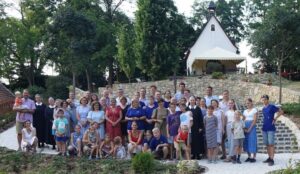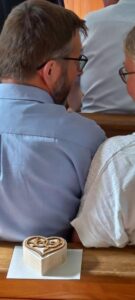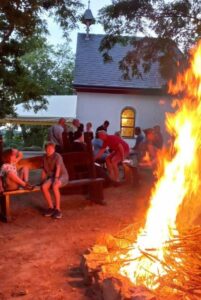Days Full of Life
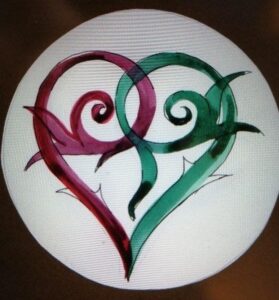
A visit to the Hungarian Schoenstatt Movement
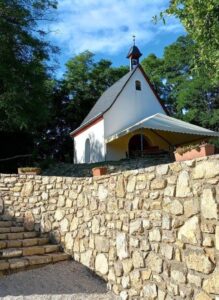
Every summer the Schoenstatt Center in Óbudavár, Hungary is filled with life. One family conference follows another. Sister Gertrud-Maria Erhard accompanies these conferences with great commitment, Know-how, and sensitivity to the groups and to each individual couple. The gratitude and sincere appreciation of the couples for her commitment is particularly noticeable when acknowledgements are given.
Each of these family conferences has its own character. Nevertheless, there are commonalities among them. The conferences, which are vacation for some, include exchange, input, couple’s discussions, games, fun, and the shared joy of creation that is obvious in and around the Schoenstatt Center.
This summer we could share this experience. A few impressions:
Impulses and thoughts that motivate
Each morning had is own rhythm. Couples filled the large room while the children began their own program. For the adults, the first step, following Father Joseph Kentenich’s proven method of prayer was to become interiorly quiet while “savoring” and “re-savoring.” The goal of this method of prayer is to recall experiences of the past day in your heart and to discover the God of life in happenings of your life.
Then came impact sessions, i.e. at least one, usually two presentations, followed by discussion in pairs. A wide range of topics, as diverse as everyday life, were opened up.
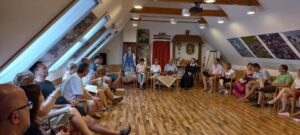
Some things were unusual and made the listeners sit up and take notice. For example, the lecture “Organic Thinking” by Viktor and Zsuzsi Soósa. The faces in the audience revealed the unspoken question: How do you come up with such a topic? The Soósas answered the question at the outset of their talk. Since they know German, they were given a text from Father Kentenich to translate. It was the sermon he gave in Bellavista, Chile on May 31, 1949. Twice, when Zsuzsi Soósa had finished the translation, the laptop crashed and she had to translate again from the beginning. But it was precisely this that brought her to a deeper understanding of the text. Since then, the sermon from Belllavista is not only a milestone in the history of Schoenstatt but also a milestone in the history of their marriage and family.
“The text touched us incredibly deeply, even if we didn’t understand much of it at the time,” said Mr. and Mrs. Soósa. And for the people who experience the Soósas, it is obvious that the they have not spoken about the text for the last time. With them, the Blessed Mother has found instruments to write the message of the thirty-first of May into the hearts and minds of married couples.
Of course, the topic of raising children was also a must. A couple whose own children are adults and who have taken in a twelve-year-old boy for a year spoke: “Education is an activity that we must learn, but if it is not imbued with spirit, if we do not leave room for grace, all our efforts are in vain … We are fortunate that Schoenstatt is a Movement of education. When our children started school, we increasingly felt we were burdened beyond our strength. We had a special resource in the Schoenstatt covenant of love wtih the Blessed Mother … She promised: “I will draw young hearts to myself and I will educate them.”
Hearts inscribed in one another
Particularly noticable was the pride of the Hungarian Schoenstatt Movement in the mission of their shrine which they discovered last year. The mission is: “Hearts inscribed in one another”.
“We approached the mission of the shrine in many different ways,” said one couple. “Now we are developing a form, a culture to make the ideal our own.” Each couple receives a small wooden box with the expressive symbol of hearts inscribed in one another. The couple explained, “It is a long process, the inscription of one heart into the heart of another. It is a mysterious, deep symbol. You can work with it for a lifetime.”
The cornerstone, on which the mission statement is carved and which was blessed by Archbishop Dr. György during the Shrine Festival on Saturday, July 6, 2024, was also the focus of their striving for a longer period of time. Then it was inserted into the wall of the shrine.
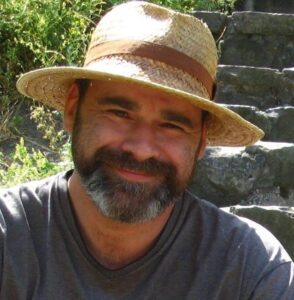
One reason for the shrine festival is the fifteenth anniversary of the death of Csaba Ozsvári. That day has left an indelible mark on the Schoenstatt Family in Hungary. Csaba Ozsvári was a goldsmith and created exclusively sacred art through which he became known beyond the borders of Hungary. He belonged to the third course of the Federation of Schoenstatt Families in Hungary. On July 9, 2009, immediately after the solemn first consecration of his course, Csaba Ozsvári collapsed next to the Schoenstatt Shrine in Óbudavár and died. It was an incomprehensible moment, but it was precisely out of this shock that the conviction grew he sealed his covenant of love by giving his life.
“I consider this the most important human virtue: to be faithful to the task God has entrusted to us, to the person to whom I have committed my life, to my wife, my family and also to my Church and my country.”
The place of his death is marked to this day and is a place of encounter time and again. Csaba Ozsvári has become a cornerstone of Schoenstatt in Hungary. The Schoenstatt Family is working with Church officials to initiate his beatification.
“We saw the life and we liked it.”
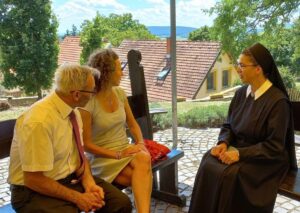
It is said that Hungarian is a difficult language. Be that what it is, in any case, we don’t speak a word of Hungarian and can’t understand anything in the Hungarian language. This made us all the more grateful for willing and cheerful translators who were always on hand.
However, life spoke for itself and increasingly so each day. We experienced many enriching conversations during these days and they have not been forgotten.
After their talk, Mr. and Mrs. Soós told us: “We don’t just give our talks on “topics” or about what we know, but about the questions we have and the answers we find to them in Schoenstatt.” And Mr. and Mrs. Török, the Leader-Couple of the Schoenstatt Movement in Hungary, explained to us, “We want to become holy families.” “That is the most important thing. We are building up the Schoenstatt Movement with the aid of the jar at the altar in the Schoenstatt Shrine–with sacrifices and prayers and contributions to the capital of grace.”
So much joy and conviction was expressed in this spontaneous answer. At the same time, it reflected the strength that emerges when life is mastered with all its ups and downs.
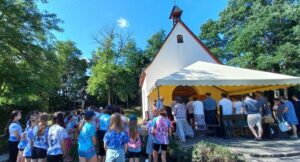
In a conversation, a young couple told us how they came to know Schoenstatt in Óbudavár, about their first meetings and experiences there, and the fact that Schoenstatt families had invited them back. At the end, the young woman leaned back with a laugh and simply said: “We saw life here and we liked it.”
Yes, that’s it. There is actually no better way for us to summarize the experiences of these days than to say;
We saw the Schoenstatt life in Hungary and we liked it!
